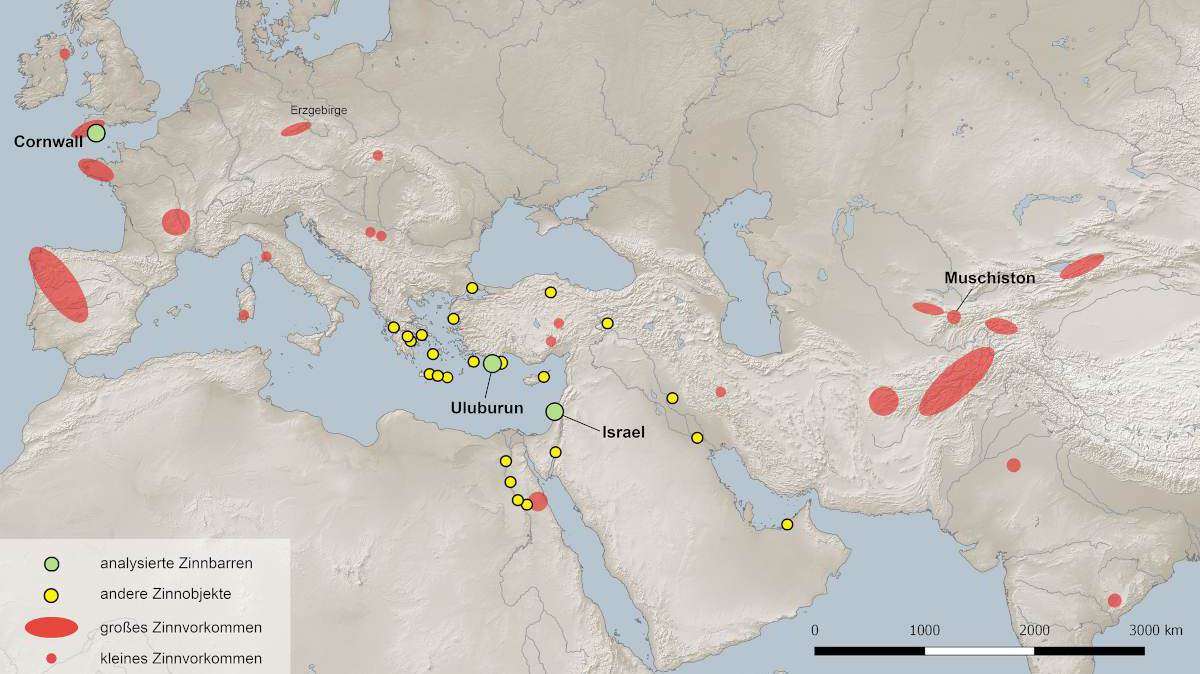The key find for solving the tin puzzle is the cargo of a stone from around 1320 BC. A merchant ship that sank off the western Turkish coast near Uluburun in 200 BC. The wreck was discovered by divers in 1982 and its cargo was recovered underwater archaeologically. In addition to luxury goods, it contained 10 tons of copper and one ton of tin ingots – far more than had ever been found before from the Bronze Age.
“Even 40 years after the discovery of Uluburun, the tin puzzle remains, even if we are getting closer and closer to the solution by using new methods,” explains Ernst Pernicka, senior professor at the University of Tübingen and scientific director of the Curt Engelhorn Center for Archaeometry CEZA the Reiss-Engelhorn Museums in Mannheim. He has been on the trail of solving the tin puzzle for four decades now.
In a recently published study in the journal Frontiers in Earth Science, Ernst Pernicka, Daniel Berger and two other authors contradict a November 2022 publication in the journal Science Advances in which Professor Wayne Powell from Brooklyn College in New York claims the origin of tin from the Uluburun shipwreck.
Wayne Powell’s team explained that most of this comes from the meineston tin deposit in northwest Tajikistan, as well as from two mines in the Taurus Mountains near what is now the Turkish-Syrian border. For its analysis, it took samples of 105 tin bars from the wreck and used them to determine chemical and isotopic signatures for 90 percent of the tin cargo. In particular, the isotope ratios of tin and lead were measured, which, in addition to the chemical composition, also provide information about the origin of the tin. In addition, the proportion of the trace element tellurium suggests tin deposits in Central Asia. The study claims to be able to derive a clear association based on the matching signatures between the Uluburun ingots and tin ore samples from the mentioned mines.
“The data do not support this interpretation, they do not allow a clear conclusion,” contradicts Dr. Daniel Berger, Ernst Pernicka’s colleague at CEZA in Mannheim and lead author of the now published study. For this review, he comprehensively considered chemical and isotopic analyzes from previous studies and compared them with Wayne Powell’s data set. “An origin of the tin ingots from the Uluburun shipwreck, at least part of the cargo, from Cornwall in Great Britain would be much more likely due to the isotope ratios and chemical characteristics. In particular, the comparison with Bronze Age tin ingots from Great Britain and Israel suggests this conclusion “We have already considered a comparable origin. Ultimately, however, the origin from the Ore Mountains or the Iberian Peninsula cannot be ruled out.” In order to substantiate these assumptions, more samples and analyzes of ores from European and Asian tin deposits are needed.
The Bronze Age lasted from the late fourth millennium to the early first millennium BC – but with different beginnings and ends depending on the region of the world. Bronze is created by fusing copper and tin in a ratio of nine to one and is significantly harder than copper alone. Copper ores can be found in many regions of the Old World. However, tin ores accessible to the Bronze Age can only be found in a few places in Central Asia in Iran and Europe. It is all the more astonishing that some of the earliest bronze artifacts come from the Mesopotamian region around the Euphrates and Tigris. But there are no tin deposits there. Only through long-distance trade could supply and demand for tin be brought together.
“Numerous archaeological evidence also shows that the British Isles and Central Europe formed an economic sphere with the Mediterranean in the Bronze Age and were connected as transport routes via the Danube, the Rhine and the Rhône, but also the sea,” said Ernst Pernicka. Amber beads were also found in the wreck of Uluburun, which had probably been traded from the Baltics. The use of standardized weights had also spread over the course of the second millennium BC from Egypt and Mesopotamia via Syria, Anatolia and the Aegean Sea to the Alps and into Central Europe. They were necessary for weighing trade goods, including tin bars. Of course, such connections also suggest a trade in tin, one of the most important raw materials of the Bronze Age. For the time of the ship from Uluburun, neither weight systems nor solid trade connections to the West can be proven for Central Asia, which further supports the origin of the tin from the West.
